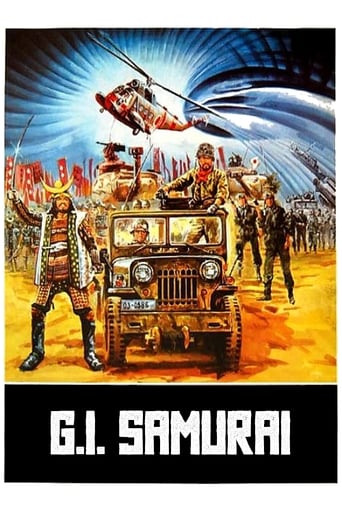Best movies & TV Shows like Awaiting Kirin
A unique, carefully handpicked, selection of the best movies like Awaiting Kirin Starring Masahiro Motoki, Shota Sometani, Hiroki Hasegawa, Haruna Kawaguchi, and more. If you liked Awaiting Kirin then you may also like: Nobunaga Concerto: The Movie, Time Runner, Indian Paint, Honnouji Hotel, G.I. Samurai and many more popular movies featured on this list. You can further filter the list even more or get a random selection from the list of similar movies, to make your selection even easier.
After the Onin War, the world is plunged into chaos. Amid this situation, heroes of the warring states begin to emerge in an attempt to unify the country and rule in these turbulent times. In the mid-1540s, there is a young wandering samurai in Mino which is strategically located between the East and West. His name is Akechi Mitsuhide. At this time, there is plenty of internal strife within the Toki clan which rules Mino. Surrounded by the Oda of Owari, the Imagawa of Suruga and the Asakura of Echizen, Mino has constantly faced the risk of invasion. Mitsuhide is pulled into battle and destroys the enemy. His bravery as well as stratagem catches the attention of Saito Toshimasa, the chief retainer of the Toki clan, and he is singled out. This man who is also known as Saito Dosan will go on to takeover the Toki and make Mino his own.
Awaiting Kirin
You may filter the list of movies on this page for a more refined, personalized selection of movies.
Still not sure what to watch click the recommend buttun below to get a movie recommendation selected from all the movies on this list
Time Runner
During the alien invasion of 2022, one man flees through a wormhole to 1992, where attempt after attempt is made to catch and kill him.
Indian Paint
Nishko is a chief's son in the Great Plains, before Europeans arrive. During his rite of passage, he's determined to tame a painted pony. He approaches manhood while his peaceful clan is set upon by a nearby tribe willing to break a treaty. He must also contend with the kidnapping of three young women from his village, his pony's illness behind enemy lines, his mother's coma after a rattlesnake bite, the medicine man's urging that he sacrifice what he loves best, the attack of a cougar and of wolves, and his own injury while alone in the woods. His kindness, bravery, and quick thinking serve him well, but rescue come from an unexpected source.
Honnouji Hotel
In Kyoto, Mayuko (Haruka Ayase) stands at a crossroad in her life. She's thinking about marriage with her boyfriend Kyoichi (Hiroyuki Hirayama). By an accidental opportunity, Mayuko stays at Honnouji Hotel. There, she meets historical figure Nobunaga Oda (Shinichi Tsutsumi) who is attempting to unify Japan.
G.I. Samurai
A squadron of Japanese Self-Defense Force soldiers find themselves transported through time to their country's warring states era, when rival samurai clans were battling to become the supreme Shogun.
Mumon: The Land of Stealth
Raised suckling poison arrows among the sparring Iga ninja factions, Mumon is a carefree 16th-century mercenary. When the ninja council makes a power play to defeat the young Nobukatsu Oda struggling to step into his father’s warlord shoes as they expand rule across the country, Mumon jumps into the fray to satisfy his new bride Okuni’s demand that he make good on his promises of wealth. Yet Mumon soon finds what is worth fighting for beyond money or nation.
Beyond Outrage
As the police launch a full-scale crackdown on organized crime, it ignites a national yakuza struggle between the Sanno of the East and Hanabishi of the West. What started as an internal strife in Outrage has now become a nationwide war in Outrage Beyond.
Rise Against the Sword
Farmer Abare Goemon is confronted by brigand-like samurai. He raises an army of farmers to fight them and does so brilliantly. When Lord Asakura sees the success Goemon has achieved, he attempts to recruit him to fight in a conflict between Asakura and another clan. Goemon refuses, and Lord Asakura sets out to destroy him.
Clan Revival
After the Onin War ended in 1477, Kyoto was left in ashes and the nation was in complete disorder. Bands of roving samurai called the "nobushi" terrorized the country under the leadership of Akagaki Genba and overthrew Mangetsu Castle in Tanba Province scattering the few survivors. Lord Niwa's two sons have been studying in China and return to Japan upon hearing of the tragedy in an attempt to restore the clan. On Mt. Oe they meet magician Kiri no Kojiro and try to enlist his aid. With touches of the supernatural and rousing sword-play can they succeed against the evil villains whose symbol is the skull mask?
Honno-Ji in Flames
The plot is based on the novel "Akechi Samanosuke no Koi," the final work in a trilogy by Hiroshi Kato about the forced suicide of Oda Nobunaga at the temple Honnoji. Historically, the general Akechi Mitsuhide is credited with causing Nobunaga's downfall. Kato's novel focuses on Mitsuhide's nephew Samanosuke, who fought alongside his uncle during the assault on Honnoji.
The Legend & Butterfly
Oda Nobunaga and Nohime were originally married to mend a hostile relationship between neighbouring regions. Unfortunately, they were like oil and water, making for a somewhat unhappy marriage. When Oda’s enemy, Imagawa Yoshimoto, attacks Owari with his vast army, Oda is devastated by the overwhelming gap in military strength. However, Nohime encourages him not to despair and the pair draw up a tactical plan that will allow them to overcome the odds.
Oda Nobunaga
Among the great ‘Warlords’ in Japanese history, Oda Nobunaga holds a unique place. In effect, his military success led to the ultimate unification of the country. This historically accurate portrayal of Nobunaga’s life and times is highlighted by many of Japan’s biggest stars, most notably Watanabe Ken in the lead role. Bloody realistic fighting, massive battles, and castle intrigues all drawn from historical sources bring this 2 part drama to new heights in storytelling.
Lucky Adventurer Nobunaga Oda
Oda Nobunaga (1534–1582) was a major daimyo during the Warring State period of Japanese history. He was the second son of Oda Nobuhide, a deputy military governor with land holdings in Owari province. Nobunaga lived a life of continuous military conquest, eventually conquering a third of Japanese daimyo before his death in 1582. Telling the story of his rise to prominence as he leads an army of 4,000 men against the 40,000 troops of Lord Imagawa Yoshimoto to prevent the arrogant daimyo from crushing the Oda clan and taking control of the entire nation. From a newly restored anamorpic widescreen print, this is the ultimate warlord movie.
Saito Dosan: Rage of Power
During the age of warring clans (Sengoku Jidai), many samurai lords sought to unite the country under their banners by becoming the supreme leader. One of the first to vie for power in this way was Saito Dosan, the 'Viper'. His son-in-law, Oda Nobunaga, did in fact unite the nation after subduing all of his enemies, yet falling at last to the treachery of one of his most trusted generals. This story is a pre-cursor to those later events as the brilliant military strategist Saito Dosan rises to power and notoriety as a great lord in his own right. Directed by Kudo Eiichi and with a tremendous supporting cast that includes Nakamura Toru as Oda Nobunaga and Chiba Shinichi as Akechi Mitsutsugu, battle scenes of awesome power and a unique view of Japanese history, this is a marvelous production highlighted by the action scenes done by the Japan Action Club (JAC).
Heroes and Villains
Heroes and Villains was a 2007-2008 BBC Television docudrama series looking at key moments in the lives and reputations of some of the greatest warriors of history. Each hour long episode featured a different historical figure, including Napoleon I of France, Attila the Hun, Spartacus, Hernán Cortés, Richard I of England, and Tokugawa Ieyasu. The statements at the beginning of each episode read: "This film depicts real events and real characters. It is based on the accounts of writers of the time. It has been written with the advice of modern historians." In the United States the show is aired on The Military Channel and was called "Warriors".
Love and Glory
Kazutoyo lived during the end of the Sengoku period (1546-1605). He was the first feudal lord of the fief of Tosa on the island of Shikoku. He served Nobunaga Oda, Hideyoshi Toyotomi and Tokugawa Ieyasu. Chiyo (1557-1617) was his wife, and was known in history for her dedication and devotion to her husband (like Matsu was to Toshiie in Toshiie to Matsu). She is the daughter of a samurai who served the feudal lord Asai.
Samurai Banners
Fūrin Kazan was the 46th NHK Taiga drama beginning on January 7, 2007. It was aired throughout 2007. The four characters from left to right are wind, woods, fire, and mountain. The title is a reference to the war banner used by Takeda Shingen, which in turn was taken from Sun Tzu's The Art of War. It means "Swift as the Wind, Silent as a Forest, Fierce as Fire and Immovable as a Mountain."
Ryōmaden
Ryōmaden is the 49th NHK Taiga drama. It was shown on NHK from January 3 to November 28, 2010 spanning 48 episodes. The story centers on the life of 19th-century Japanese historical figures Iwasaki Yatarō and Sakamoto Ryōma. It has been announced that the series will be aired in several other countries, for example Hong Kong, South Korea, Taiwan and Thailand.
Yoshitsune
Yoshitsune is a Japanese television drama series originally broadcast between 9 January and 11 December 2005, with a three-part special compilation being aired from 24 December to 25 December 2005. The 44th Taiga Drama, the original work is by Miyao Tomiko, screenplay by Kaneko Narito and starring Hideaki Takizawa.
Musashi
Orphaned when he was not yet ten, Musashi grows up skilled in the martial arts. During the Battle of Sekigahara, he fights on the side of the losing Toyotomi forces, but eludes the enemy as they hunt down the vanquished soldiers. He then spends years wandering the countryside mastering the sword. As his fame spreads throughout the nation, men seek him out to test their skills against him--most notably Sasaki Kojiro who faces Musashi in the ultimate duel at Ganryujima.
Taira no Kiyomori
Villain or hero, Taira no Kiyomori changed Japanese history forever 900 years ago. Without ever knowing his real father, Kiyomori was raised as a samurai. Together with his stepfather, he wiped out piracy along Japan's western coast, becoming a full-fledged warrior samurai. In an age when samurai were looked down on as members of the lower class, Kiyomori was skillful at winning the hearts and minds of the people. By rounding up surrendered pirates and achieving other successes, Kiyomori eventually became the de facto ruler of Japan.
Sengoku BASARA: Samurai Kings
During the Sengoku period, there are many factions constantly at war. One of these is led by a one-eyed man named Date Masamune and another by the imposing Takeda Shingen. The latter has a fiercely loyal subordinate named Sanada Yukimura who goes head to head against Date Masamune multiple times, but the battles between them tend to get interrupted. One such battle occurs when both men try to go after another leader named Imagawa, and they’re forced to break off their heated duel when Imagawa attempts to flee the scene with his body doubles. Yukimura and Masamune go after separate Imagawas, but all of the doubles are killed by a third party, and when their paths cross again, they are in front of the menacing Oda Nobunaga and his army. It was Nobunaga’s subordinates that killed those body doubles, and Nobunaga himself proceeds to kill the real Imagawa with a shotgun blast to the head.
Yae's Sakura
Yae no Sakura is a 2013 Japanese television series. It is the 52nd NHK taiga drama. The story focuses on Niijima Yae, who is portrayed by Haruka Ayase.
Katanagatari
The legendary swordsmith Kiki Shikizaki created 1,000 swords in his career. The more of the swords a country owns, the higher its chances are at winning a war. When the shogun emerged victorious, he collected 988 swords, but these were merely the “practice pieces”. The last twelve swords were the crowning achievements of Kiki’s career. Each one of them is so powerful that a single man could defeat an army with it. Togame, the shogun’s strategist, gets the order to collect these swords. At first she hired a ninja, but each of the swords’ value is so high that the entire ninja clan went rogue once they got hold of one. She then put her trust in another warrior, but he kept the sword for himself. Her final hope now is Shichika, the seventh and last student of the Kyotoryuu School.
The Ambition of Oda Nobuna
The historical romantic comedy follows 17-year-old high schooler Sagara Yoshiharu who one day time-travels to the Sengoku period, where all the major Samurai lords are cute girls. Yoshiharu meets Oda Nobuna, the girl counterpart of Oda Nobunaga, and begins to serve her as a substitute of Kinoshita Toukichirou, who has been dead in the world.
Hojo Tokimune
The 40th NHK Taiga Drama is Hojo Tokimune. It tells the dramatic and turbulent life of young shikken Hojo Tokimune, and his successful defense of Japan from invasion by Mongolia in the 1200's. It is a tragic story of betrayal and clan wars and Hojo Tokimune is at the center of it all. The main focus of the story is Hojo Tokiyori's older sons, their relationship, and their views and actions concerning Kublai Khan's attempted invasion. The two brothers, Tokimune and Tokisuke, are torn apart by politics.
Nobunaga Concerto
Saburo is a high school student good in sports, but not very good with his studies. One day, Saburo travels back in time and arrives in the Sengoku period of 1549. There, Saburo meets Nobunaga Oda who looks and sounds just like Saburo. Nobunaga Oda is the son of a warlord and magistrate of the lower Owari Province. Nobunaga Oda, though, is physically weak, and he asks Saburo to take his place. Then, Saburo as Nobunaga Oda attempts to unify the country of Japan.
Strategist KANBE
July 1590, Odawara. Toyotomi Hideyoshi's army had surrounded the Odawara Castle for over 3 months, hoping to conquer this last obstacle to his dream of the country's unification. Standing at the gate of the castle, a lone man facing the menacing guards shouted out: "Do not throw your lives away. Treasure living!". Not long after, the castle gates opened and the reigning lord surrendered. The name of that man is Kuroda Kanbee. An excellent military strategist, he worked hand-in-hand with Hideyoshi to unify the country.
Burning Flower
Fumi becomes Genzui Kusaka’s wife. During the turbulent times of the closing days for the Tokugawa shogunate, she lives positively and tries to keep up Shoin Yoshida's will. Shoin Yoshida is her older brother and intellectual.
The Heroic Legend of Arslan
Arslan is the heir apparent of Pars, a strong nation that sits at the hear of the trade route connecting the East and the West. When the pagan nation of Lusitania begins an invasion of Pars, the timid Arslan is confronted with battle for the first time. His worst anxieties are realized the Parsian army falls for a Lusitanian stratagem and are routed. He barely escapes with his life, thanks to the loyal and indomitable warrior Daryun. Together they will stand against the invasion and the cruelties of fate that are about to blow down on Pars.
Ninja Girl & Samurai Master
The anime centers on a young female ninja named Chidori, whose dream is to help the Warring States-era warlord Oda Nobunaga to achieve his goals.
Naotora: The Lady Warlord
Naotora Ii is a woman given a male name, who succeeded as the head of the Ii family during the Warring States period when her father passed away. With her wisdom, courage and affection for loved ones, Naotora lived through turbulent times and paved the way for the future of her clan.
Segodon
Saigo Takamori, the hero of the Meiji Restoration, was born to a poor, low-ranking samurai family in the Satsuma domain (present day Kagoshima Prefecture). His simple honesty caught the attention of its charismatic feudal lord of Satsuma, Shimazu Nariakira. Nariakira’s assertion that the love of people is what will enrich and strengthen the nation captivated Saigo who took on Nariakira’s secret mission and eventually became a key person for Satsuma. Not a portrait of him survives today and much of his life is a mystery. He is a man who was twice exiled and thrice married. He overthrew the Tokugawa Shogunate with exceptional bravery and action. Although he accomplished the restoration, he lost his life in a fight with the new Meiji government.
Shinsengumi Keppūroku
Shinsengumi Keppuroku is a novel by Ryōtarō Shiba and a television series which aired in 1998. The arrival of Matthew Perry's Black Ships rudely awakened Japan from 300 years of isolation from the world. Men set their eyes beyond Japan and began to demand change in society. Old clashed with the new, and thus began an age of turmoil. Amidst this confusion, one group remained true to the old ways and risked their lives to preserve the traditional shogunate system. Led by their charismatic captain, Kondo Isami, the Shinsengumi upheld the code of honor of the samurai. Tales abound of the feats of men like Kondo, Hijikata Toshizo and Okita Soshi. In general, the passion and glory of these men who lived during these turbulent times in Japanese history are given exploration.
Genroku Ryoran
The 38th NHK Taiga Drama is Genroku Ryoran. The "Forty-seven Loyal Samurai" is one of the most enduring and best loved stories of Japan's history. Generations have grown up hearing the stirring tale of Oishi Kuranosuke, chief councillor of the Ako clan who leads his men through suffering and hardship to ultimately avenge their lord after he is unjustly forced to commit harakiri. NHK's 38th Taiga Drama "Genroku Ryoran" is the ambitious remake of this classic epic and boasts a cast that reads like a Who's Who in Japanese entertainment.
Toshiie and Matsu
The 41st NHK Taiga Drama is Toshiie to Matsu. During the turbulent Warring States Era, one man's life and career intertwined with the three great generals of Japanese history-Nobunaga, Hideyoshi, and Ieyasu. With political savvy and the support of his fiercely loyal wife, Maeda Toshiie rose to second in power in the shogunate and built up a fiefdom that encompassed Echizen, Noto and Kaga.
Three Generations of the Yagyu Sword
After the 'Incident at Honnoji' (assassination of Oda Nobunaga by Akechi Mitsuhide, a former trusted general), a group of Tokugawa samurai are rescued by a youth named Yagyu Munenori (2nd son of Yagyu Sekishusai from Yamato) and Kizaru (a Ninja), as they are chased by a bloodthirsty group of samurai. Tokugawa Ieyasu, the lord of his clan, then lave a very special gift to Munenori; a samurai's pillbox, (a veritable work of art, with beautiful lacquered designs) which signifies that he is to be hired by the Tokugawa Clan when he grows up. As a result of the assassination, Toyotomi Hideyoshi became the sole ruler of Japan, and confiscated the Yagyu lands since they had sided with the traitorous Akechi. The Yagyu Clan was considerably weakened, and all but disappeared during Hideyoshi's reign as 'Taiko'.
Japan: Memoirs of a Secret Empire
Commanding shoguns and samurai warriors, exotic geisha and exquisite artisans—all were part of the Japanese “renaissance”; a period between the 16th and 19th Centuries when Japan went from chaos and violence to a land of ritual refinement and peace. But stability came at a price: for nearly 250 years, Japan was a land closed to the Western world, ruled by the Shogun under his absolute power and control. Japan: Memoirs of a Secret Empire brings to life the unknown story of a mysterious empire, its relationship with the West, and the forging of a nation that would emerge as one of the most important countries in the world.
Kengan Ashura
Since the Edo periods of Japan, gladiator arenas exist in certain areas. In these arenas, wealthy business owners and merchants hire gladiators to fight in unarmed combat where winner takes all. Toki Taouma, nicknamed "Ashura," joins these arenas and devastates his opponents. His spectacular ability to crush his enemies catches the attention of the big business owners, including the Nogi Group chairman, Nogi Hideki.
Hideyoshi
A dramatized biography of the second of Japan's three legendary leaders. Rising from obscurity, Hideyoshi served under the command of Oda Nobunaga. With an extraordinary combination of intelligence, bravery and military skill, Hideyoshi rose to near-absolute power and greatly expanded upon Nobunaga's unification of Japan's warlords. This series also focused on Hideyoshi's personal life, particularly his relationships with his mother and his wife, and the pair's rivalry for influence over him.
Age of Samurai: Battle for Japan
Dynamic reenactments and expert commentaries bring to life the tumultuous history and power struggles of a warring 16th-century feudal Japan.
Masamune Shogun
Broadcast TV drama NHK broadcast on January 4 to December 13, 1987 (Showa 62). In the questionnaire survey conducted by NHK, it is shining in the most favorite river drama. The original is Yamaka Sosaichi's novel "Date Masamune", the biggest drama on the theme of the Date house was the first time in 17 years since the "Shinnogi remained" (1970), which painted Datejo in the Edo period. It depicts the life of Matsudo Date of Sengoku warrior · Date Masamune who built the foundation of Sendai clan 620,000 stones in his generation as a result of my own wisdom and talent.
Rurouni Kenshin
Ten years have passed since the end of Bakumatsu, an era of war that saw the uprising of citizens against the Tokugawa shogunate. The revolutionaries wanted to create a time of peace, and a thriving country free from oppression. The new age of Meiji has come, but peace has not yet been achieved. Swords are banned but people are still murdered in the streets. Orphans of war veterans are left with nowhere to go, while the government seems content to just line their pockets with money.
Kunitori Monogatari
Set in Japan several centuries back. It depicts the struggles of three historical warriors, Dosan Saito, Nobunaga Oda and Mitsuhide Akechi.
Shin Heike Monogatari
Set at the end of the 12th century when several wars for control of Japan disrupted a long era of peace, this tale of "Heike" (another name for the Taira clan) focuses on Taira Kiyomori who fights alongside other members of his clan to at first successfully overcome the Minamoto clan and their bid for power. Battles and intrigue abound, as the puppet Emperor and Buddhist monks take sides in the power struggle. At issue is Kiyomori's parentage, not an unusual problem for the nobility in that era where clandestine liaisons among courtiers and the upper classes were common.
The Story of Dominating Countries
Based on the award-winning novel by Shiba Ryotaro, the drama is set in Japan several centuries back in the Sengoku period. It depicts the struggles of three historical warriors, Saito Dosan, Oda Nobunaga and Akechi Mitsuhide.
Mominoki wa Nokotta
Depicting Date clan’s internal strife that occurred during a peaceful Edo period governed by the 4th Tokugawa shogun.
Eighth Shogun Yoshimune
The drama is depicting the life and times in 17th and 18th century Japan during the rule of the eighth shogun, Tokugawa Yoshimune.
































































Nobunaga Concerto: The Movie
Saburo is a high school student good in sports, but not very good with his studies. One day, Saburo travels back in time and arrives in the Sengoku period of 1549. There, Saburo meets Nobunaga Oda who looks and sounds just like Saburo. Nobunaga Oda is the son of a warlord and magistrate of the lower Owari Province. Nobunaga Oda though is physically weak and he asks Saburo to take his place. Then, Saburo as Nobunaga Oda attempts to unify the country of Japan.